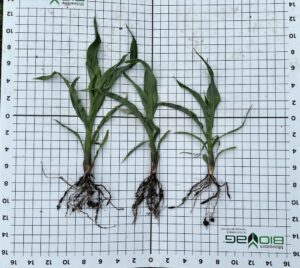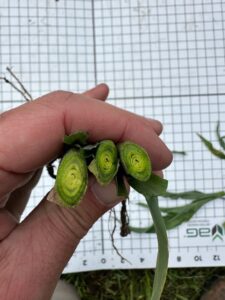June Field Insights: Early Post-Emergence Results Show Promising Outcomes
Throughout the month of June, our research team concentrated on collecting post-emergence data across our on-farm trials in Iowa, Minnesota, and Wisconsin. Preliminary visual assessments indicate that Bio-Gel® NSurge™
is performing exceptionally well in promoting early root development. Robust root systems are critical for maximizing nutrient uptake later in the season, and early indications suggest that these foundations are being effectively established.
In addition, we’re observing highly encouraging results following the application of TerraNu, which continues to demonstrate strong agronomic performance across our test sites.

Bio-Gel NSurge Trial: Early Root Development in Northwestern Iowa
This set of samples in the image above, was collected from a trial site in Northwestern Iowa. Visual comparisons across treatment highlight the impact of Bio-Gel NSurge on early plant development. The control sample (right) performed similarly to the 1 qt/ac application rate in terms of plant height and foliage. However, plants treated with 1 qt/ac showed noticeably more vigorous and numerous root structures, even though root length remained comparable to the control. Lead canopy was also slightly fuller in the treated plant, though not significantly taller.
The contrast becomes more pronounced with the 2 qt/ac application of Bio-Gel NSurge. Plants at this rate exhibited significantly taller and thicker stems – several inches taller and visibly more robust than both the control and the 1 qt/ac treatment. Thicker stalks contribute to greater structural integrity, enhancing resilience against wind and inclement weather.
Additionally, the higher application rate resulted in broader and deeper root systems. Roots extended wider and approximately an inch deeper than those in the control and mid-rate treatments. This improved root standability supports not only stronger, more resilient plants but also enhances nutrient uptake and availability as the crop beings to enter reproductive stages.
This trial offers a clear example of how improved soil health, driven by targeted biological inputs, lays the groundwork for high yields and more productive growing seasons.

Visual Evidence of Stem Development: Bio-Gel NSurge Application Rates Compared
The image above, captured at the same Northwestern Iowa farm, clearly illustrates differences in stem development across treatment rates. The control plant (right) exhibits stem thickness nearly equivalent to the 1 qt/ac application of Bio-Gel NSurge (center). However, the 2 qt/ac application (left) demonstrates a significantly thicker and more structurally defined stalk and pith.
This enhanced stem development contributes to stronger, more resilient plants – better equipped to withstand environmental stressors such as wind and adverse weather. A more robust stalk also supports improved nutrient transport and uptake throughout the plant’s lifecycle.
In essence, Bio-Gel NSurge is already promoting early-season growth that helps safeguard yield potential and improve final crop performance – by strengthening the plant from the ground up though improved soil biology.

